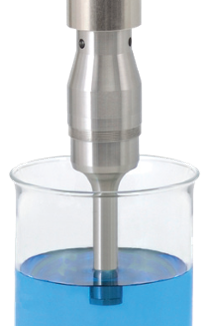Magnetic bead suspensions will eventually sediment and aggregate over time. If non-homogeneous biomagnetic separation conditions are used, studies show that the likelihood of irreversible aggregation occurring is very high. Unfortunately, when this happens, the consistency, quality and functionality of the lot are all compromised. There are several steps during the preparation of magnetic beads for diagnostic kits where irreversible aggregation can become a problem unless resuspension techniques are used that guarantee gentle disaggregation.
This post is about resuspension techniques, such as the sonication method, and how they can solve magnetic bead aggregation. If you are interested in this topic, download our free ebook The basic guide for resuspending magnetic beads:
Solving magnetic bead aggregation
Resuspension techniques include vortexing, roller bottle mixing, overhead mixing, magnetic stirrer mixing and sonication. However, many of this techniques don't have great success at breaking particle aggregation on their own. Of these five techniques, only sonication can break apart irreversible aggregates that have formed during the biomagnetic separation process, although sonication should always be used in conjunction with homogenization/mixing techniques.
Before considering sonication, you must first understand why your beads become aggregated. Beads can aggregate irreversibly for three main reasons:
- If you did not completely block the exposed hydrophilic bead surface, the chance of your beads self-aggregating increases. Understanding what agent is best used to block the entire surface of your beads is crucial to avoiding this type of aggregation. There are many available blocking reagents and, depending on your ligand and bead surface properties, you must choose the one that is optimal for your system.
- If you do not follow the proper protocols after each processing step to wash and rehomogenize the beads, aggregates will only accumulate over time and change the dynamics of how the beads are separated.
- If you apply excessive magnetic force over long periods of time in the retention area during the separation process, electrostatic forces that normally keep the beads separate from one another can be overpowered by the magnetic force, causing serious problems with clumping. Homogeneous biomagnetic separators can help prevent this from happening.

Especially in non-homogeneous biomagnetic separation methods, irreverisible aggregation is one of the major concerns during the preparation of magnetic beads for diagnostic kits and other applications.
It is an unfortunate fact that aggregates can introduce a high degree of variability and inconsistency in the end product. When aggregation is unavoidable and cannot be resolved with standard mixing or homogenization, sonication becomes the preferred choice to overcome the attractive forces holding the clumped beads together.
Considerations before using a sonicator
It is important to know how to use a sonicator and how sonication works before starting the process.
Sonication is the application of ultrasonic frequencies (greater than 20 kHz) to a sample. These high frequency sound waves agitate the particles in the sample. There are two main formats for sonication: bath and probe. The bath sonicator is typically filled with distilled water and the sound waves propagate through the water. The sample is contained within another container and is placed into the water bath, often on a floating material or attached to a support arm immersed in the water bath. The advantage to this technique is that the chance of sample contamination is very low. The disadvantage is that it isn’t very direct. The sonication probe is a very direct method in which a probe is inserted into the sample. This means that the ultrasonic waves are directly agitating the particles in the sample without needing to travel through multiple vessel walls as in the bath method. However, the chances of contamination are higher so this might not be ideal for sensitive biological samples. Another complication to the probe method is that y
ou must choose the proper sonication probe that is optimal for both the volume of the vessel and the intensity desired,
Other considerations for how to use a sonicator:
- The operator must optimize the depth of the sonication https://www.istockphoto.com/vector/sparkling-golden-particles-on-black-gm1046475462-279984464probe in the vessel
- The operator must ensure that the temperature of the suspension remains stable during sonication, especially in small volume vessels. This is a critically important point to consider since very high temperatures can ruin the biological functionality of a sample
- Repeated short cycles of mixing and sonication are preferable over long sonication times in order to avoid temperature fluctuations and sedimentation problems.
- the sonication probe must always be kept clean to avoid cross-contamination.
The limitations of the sonication method must also be understood and considered when learning how to use a sonicator. These include:
- The necessity for the probe to be in direct contact with the sample (thereby increasing the likelihood of cross-contamination).
- The probe design is always specific to the type of vessel and will not translate or extrapolate to different vessel sizes and shapes. A probe that is extremely efficient for one vessel can be very unreliable for a different vessel.
- Sonication reproducibility is very tricky. Even with all things being equal in a sonication reaction, small differences in temperature, probe position and volume can affect reproducibility.
- Microstreaming is typically found only near the probe, so it is important to keep the beads in suspension with mix-sonication cycles.
The best solution is to avoid irreversible aggregation in the first place by making sure your beads are sufficiently coated and by using homogeneous biomagnetic separation techniques. Homogeneous techniques avoid clumping since excessive magnetic forces over time are not necessary. Homogeneous separation processes provide the same magnetic force everywhere in the vessel, thus exposing beads to gentler conditions over shorter periods of time. These techniques provide the end user with much higher lot-to-lot consistencies due to the lack of damaged and irreversibly aggregated beads.
Don't forget to check these posts from our blog in order to get a deeper insight into magnetic bead resuspension:
- Why is magnetic bead resuspension important?
- The Five Most Used Resuspension Methods: What Works and What Doesn't
- The Two Questions You Must Ask Before Using the Sonication Method with Magnetic Beads






